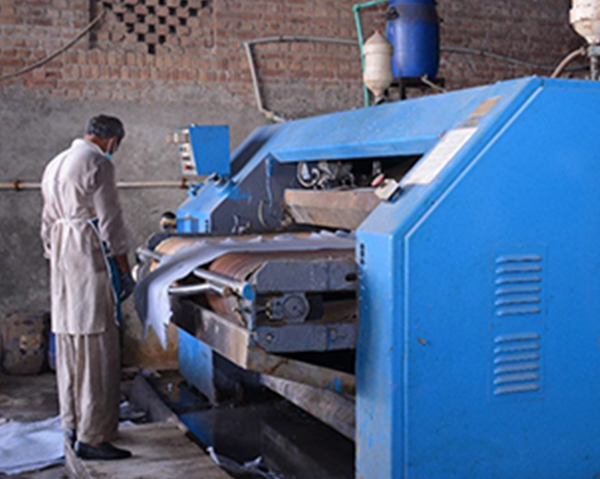Sammying is one of the critical stages in leather production in Iran, performed after tanning and before drying. The main objective of this stage is to reduce the excess moisture in tanned hides without damaging the fiber structure or compromising their uniformity.
At the end of the tanning process, leather still retains a significant amount of moisture—sometimes more than what is desirable for subsequent finishing operations such as dyeing or surface finishing. During the sammying stage, heavy-duty sammying machines equipped with rollers and high-pressure systems mechanically remove excess water from the leather. In addition to lowering the moisture content, this process also flattens and levels the leather, providing better preparation for the following stages.
In Iranian tanneries and workshops, sammying is carried out in such a way that the final moisture content of leather is typically maintained between 55% and 65%. This range is critical for preserving the dimensional stability of leather and preventing issues such as uneven drying, poor dye penetration, or irregular finishing. If too much moisture remains, there is an increased risk of deformation and reduced final quality, whereas over-dehydration can weaken the fiber structure. Therefore, maintaining a precise balance between applied pressure, processing speed, and leather thickness is the key to success in this stage.
Beyond moisture reduction, sammying also plays an important role in improving production efficiency. By shortening the drying time and ensuring uniform moisture distribution, this stage creates ideal conditions for high-quality dyeing, fatliquoring, and finishing. Sammying settings are usually customized according to thickness, softness, and the intended final product. For instance, thin and delicate sheepskins or goatskins require gentler pressure, while thicker cowhides or buffalo hides can withstand higher pressures.
Key characteristics of the sammying process in Iran’s leather industry:
- Mechanical removal of excess moisture after tanning
- Preparation of leather for uniform and controlled drying
- Reduction of moisture to an optimal level (55–65%) without fiber damage
- Improvement of surface uniformity and dimensional stability
- Process adjustment based on leather type, thickness, and final application


No comments yet.